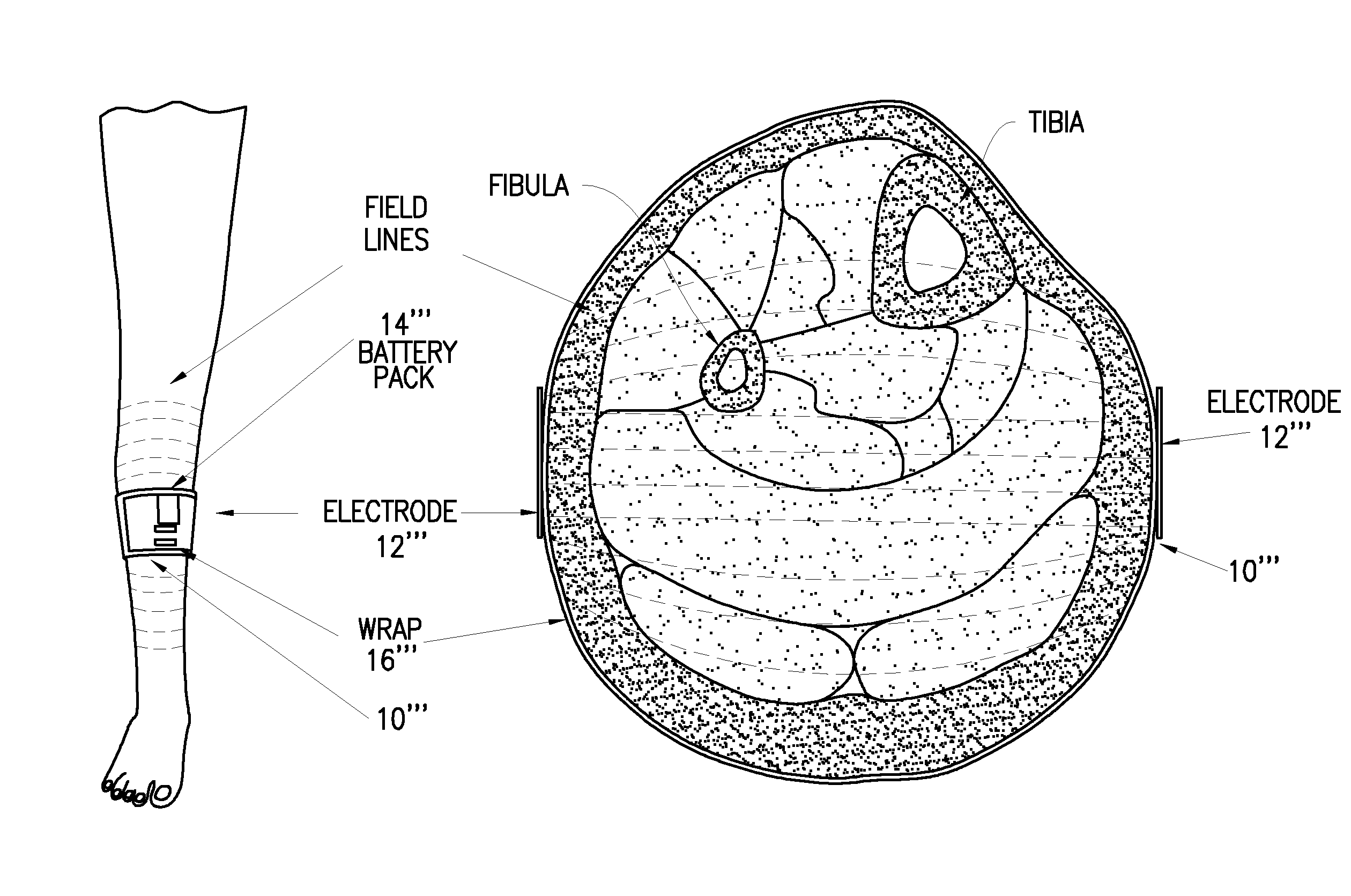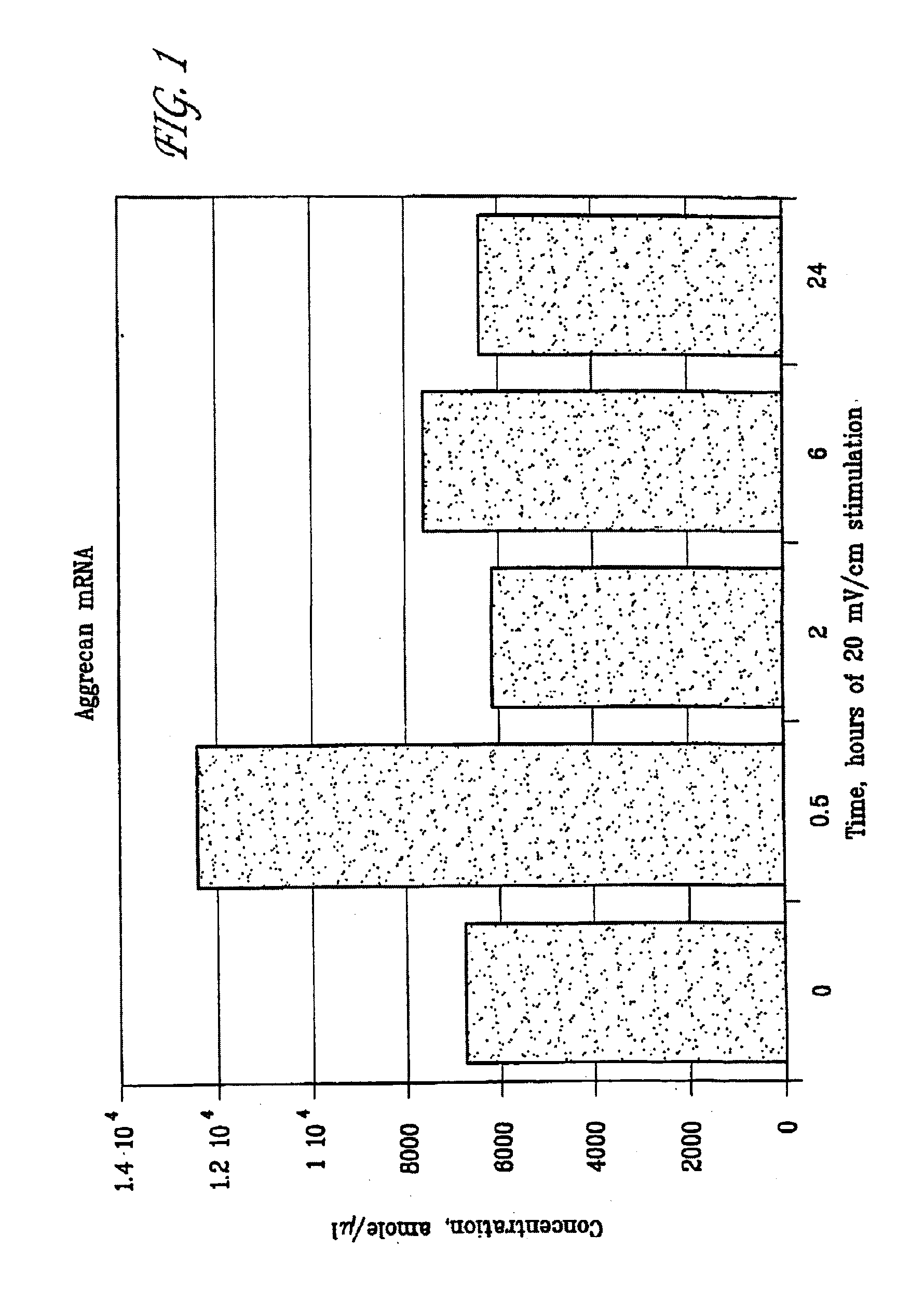Regulation of vascular endothelial growth factor (VEGF) gene expression in tissue via the application of electric and/or electromagnetic fields
a technology of vascular endothelial growth factor and gene expression regulation, which is applied in the direction of external electrodes, internal electrodes, therapy, etc., can solve the problems of nsaids that may be deleterious to patients, aspirin inhibits proteoglycan synthesis and normal cartilaginous repair processes, and nsaids that have well known toxic effects on patients' stomachs, etc., to achieve effective upregulation of vegf expression, promote vas
- Summary
- Abstract
- Description
- Claims
- Application Information
AI Technical Summary
Benefits of technology
Problems solved by technology
Method used
Image
Examples
example 1
Aggrecan Production by Articular Chondrocytes
[0079]Articular chondrocytes were exposed to a capacitively coupled electric signal of 20 mV / cm at 60 kHz. The results are illustrated in FIGS. 1-4.
[0080]FIG. 1 is a graphic representation of aggrecan mRNA production by articular cartilage chondrocytes (attomole per μl) stimulated with a 20 mV / cm capacitively coupled electric field for time durations of 0 (control), 0.5, 2, 6, and 24 hours. In this example, 30 minutes stimulation was found to provide a significant increase (almost a two-fold increase) in aggrecan mRNA. The response is thus time duration specific.
[0081]FIG. 2 is a graphic representation of the duration and magnitude of aggrecan mRNA up-regulation in articular cartilage chondrocytes following 30 minutes stimulation with a 20 mV / cm (60 kHz) capacitively coupled electric field. As illustrated, it was found that the peak up-regulation occurs 3½ hours following the cessation of the 30 minute stimulation period. FIG. 2 also illu...
example 2
Type II Collagen Production by Articular Chondrocytes
[0084]Articular chondrocytes were exposed to a capacitively coupled electric signal of 20 mV / cm at 60 kHz. The results are illustrated in FIGS. 5-7.
[0085]FIG. 5 is a graphic representation of Type II collagen mRNA production (attomole per .mu.l) in articular chondrocytes stimulated by a 20 mV / cm (60 kHz) capacitively coupled electric field for time durations of 0 (control), 0.5, 2, 6 and 24 hours. In this example, 30 minutes of stimulation provided a significant increase (approximately ten-fold increase) in collagen Type II mRNA. This shows that the response is time duration specific, similar to that of the complementary aggrecan mRNA of Example 1.
[0086]FIG. 6 is a graphic representation of the duration and magnitude of Type II collagen mRNA up-regulation in articular chondrocytes following 30 minutes stimulation with a 20 mV / cm capacitively coupled electric field. FIG. 6 illustrates that peak up-regulation occurs 5½ hours followi...
example 3
MMP-1 mRNA Production in IL-β1 Treated Articular Chondrocytes
[0089]Articular chondrocytes were exposed to a capacitively coupled electric signal of 20 mV / cm at 60 kHz. The results are illustrated in FIG. 8.
[0090]FIG. 8 is a graphic representation of MMP-1 mRNA production by articular cartilage chondrocytes treated with IL-β1 and stimulated with a 20 mV / cm (60 kHz) capacitively coupled field for time durations of 0 (control), 0.5, 2, 6, and 24 hours. As illustrated, MMP-1 mRNA is dramatically down-regulated in all time durations of stimulation, but especially so at 30 minutes. This is significant when contrasted with the dramatic up-regulation of aggrecan mRNA (FIGS. 1-4) and Type II collagen mRNA (FIGS. 5-7) in the same 20 mV / cm field. This shows the selectivity and specificity of these electric fields whereby a specific signal must be used for a selected gene response.
PUM
 Login to View More
Login to View More Abstract
Description
Claims
Application Information
 Login to View More
Login to View More - R&D
- Intellectual Property
- Life Sciences
- Materials
- Tech Scout
- Unparalleled Data Quality
- Higher Quality Content
- 60% Fewer Hallucinations
Browse by: Latest US Patents, China's latest patents, Technical Efficacy Thesaurus, Application Domain, Technology Topic, Popular Technical Reports.
© 2025 PatSnap. All rights reserved.Legal|Privacy policy|Modern Slavery Act Transparency Statement|Sitemap|About US| Contact US: help@patsnap.com



